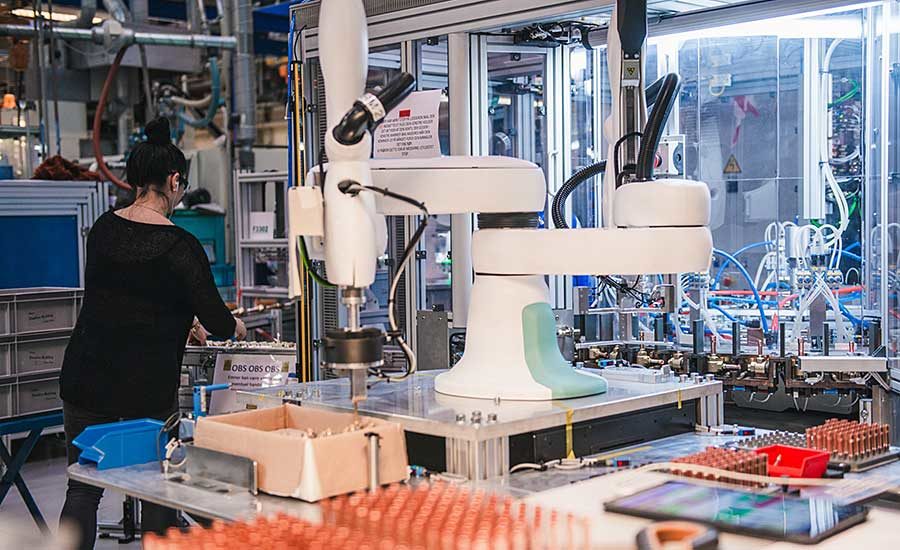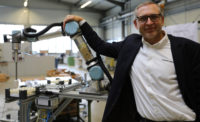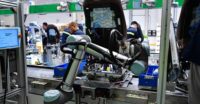Valves are a key component of heating, air-conditioning and refrigeration equipment. For example, in systems that use water as a medium for heating and cooling, balancing valves regulate the flow of hot or cold water to the various terminals in the system. In air-conditioning and refrigeration systems, expansion valves control the flow of refrigerant between the compressor, condenser and evaporator.
Based in Nordborg, Denmark, Danfoss has been making valves for heating and cooling systems since the company was founded back in 1933. Until August 2020, the work of assembling one type of valve was completely manual and required seven people. Assemblers had to pull screwdrivers down and up again above shoulder height at very short intervals.
To improve ergonomics and increase productivity, Danfoss decided to automate the process. Working with BILA A/S, a systems integrator based in Nykøbing Mors, Denmark, Danfoss engineers designed and installed a robotic assembly cell. Now, instead of seven people, the cell consists of three people and three duAro collaborative robots from Kawasaki Robotics. The people carry out only the complex parts of the assembly process, which require great accuracy and attention to detail. The remaining four employees now perform other tasks at the factory.
“We have succeeded in eliminating some of the manual processes with monotonous and strenuous tasks that strain employees’ shoulders and arms,” says Michael Breumsø, vice president of the refrigeration and air-conditioning supply chain at Danfoss. “This is the way forward: Robots can help ensure that industrial workers have a healthier work environment—one in which we can work in until we reach the age of 75.”
The employees have accepted the new cell, pointing out that the robots are quiet and easy to operate.
“In the past, we were used to new machinery [with steep learning curves], but not with this technology,” says Breumsø. “It made a difference that a duAro cobot was provided to us early in the project, so that we could all see it before implementation. I think this helped to demystify the technology.”
Danfoss is one of the first manufacturers in Europe to deploy duAro cobots. The duAro is a SCARA robot with two horizontal articulated arms originating from a single axis. Each arm can move independently, or the two can work with coordinated motion. Low-power motors, a soft body, and speed and shared work zone monitoring ensure safe operation when working side by side with people. In the event of a collision, the collision detection function instantaneously stops the cobot’s movement. Two models are available: the duAro1 and duAro 2. Each arm of the duAro1 has a maximum reach of 760 millimeters and a Z axis of 150 millimeters. Repeatability is ±0.05 millimeter. Each arm can carry a maximum payload of 2 kilograms. Each arm of the duAro2 has a maximum reach of 785 millimeters and a Z axis of 550 millimeters. Repeatability is ±0.05 millimeter. Each arm can carry a maximum payload of 3 kilograms.
The wheeled base of the cobot holds the controller. A direct teach function allows the operator to program the cobot by hand-guiding each arm. It also can be programmed using a PC or tablet terminal by entering numerical values indicating the direction and distance of each movement.
Danfoss uses several types of robots from multiple manufacturers throughout its production operations. Even so, the duAro robots have stood out. “The duAro robots are especially good for us, because they are less bulky than [conventional robots, which require shielding], and because they are faster than other cobots, since they have two arms,” says Breumsø. “The cell is easy to monitor because it is not enclosed with a roof, Plexiglas, electronic safety net or soundproofing. This provides an open and flexible workflow and a good cycle time.”
Fast Deployment
Danfoss took a new approach when choosing automation technology and a supplier. As a result, the entire project lasted only seven to eight months from idea to operation.
“Normally, we do a lot of technical preparatory work ourselves, with 70 to 80 pages of technical writing for suppliers with requirements and detailed specifications of equipment, and then we run a tender process,” says Breumsø. “In this case, however, we chose to ask BILA to draw up a proposal from the outset. It was about making sure that we got the best possible technical solution, and not just the solution that we wanted to have. Working so closely with the supplier from the start actually reduced implementation time by three to six months, and we saved a lot of time on meetings and technical processing.”
The three-cobot cell was commissioned after a thorough analysis in which engineers from BILA and Danfoss screened the entire factory for automation potential and came up with 20 possibilities for process optimization. Danfoss chose to implement four of those projects, which included the duAro cell for valve assembly. All together, the four process optimization projects enabled Danfoss to improve factorywide productivity by more than 10 percent in less than a year. Danfoss expects the automation investment to pay for itself in two years.
The company plans to reuse the automation concept and the collaborative model at other factories in the Danfoss Group.
“When many of the low-hanging fruits have been picked in terms of automation, then the next step is cobots, where some of the task can be automated and other parts are handled manually,” says Peter Suhr, global key account manager for BILA, who helped to identify the automation potential at Danfoss. “This can really improve a manufacturer’s competitiveness in a global market.”
For more information on industrial robots and cobots, visit Kawasaki Robotics’ website here. For more information on automated assembly systems, visit BILA’s website here.
To see a video of the cobot assembly cell at Danfoss, click here.






